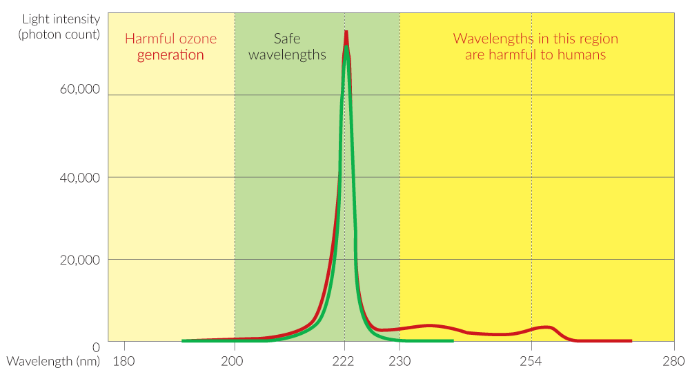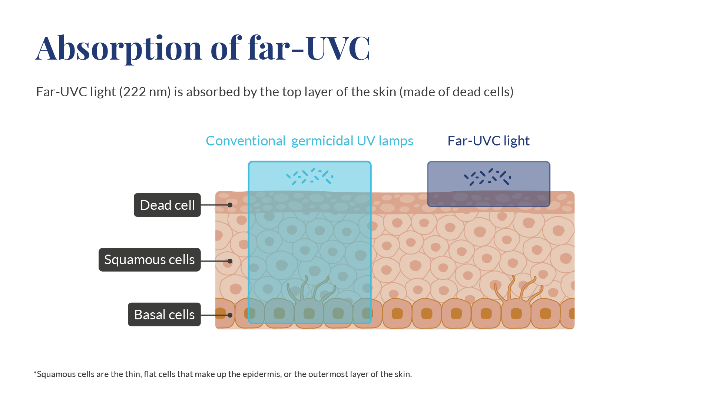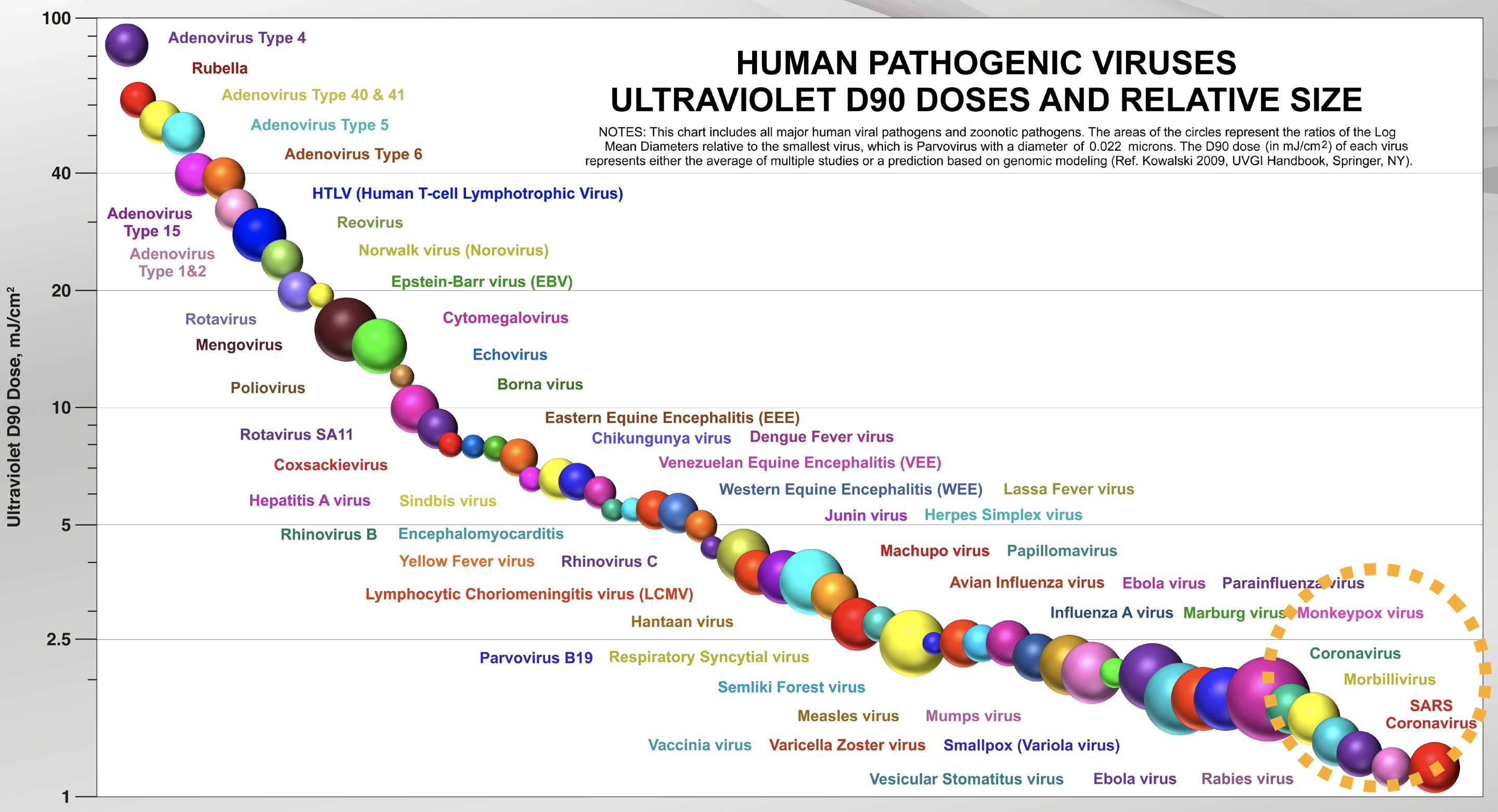Technology
After more than a century the next iteration of UV germicidal light has arrived
The technology explained by Nicolas Volet, Co-founder & CTO, UV Medico
Decades of UV light disinfection
UV light has been used for over a century to disinfect environments by removing viruses and bacteria. However, most UV light is also harmful to human tissue, which means people cannot be present in the room when the light is on.
At the same time, traditional disinfection lamps known as excimer lamps, are big, bulky instruments only fit for a lab.
However, this has all changed with UV222™
Producing a narrow band of safe Ultraviolet light
UV Medico's Far UV-C emitter consists of a tube filled with a gas called krypton chloride. This gas has the unique property of emitting UV-C-light at 222 nm when an electrical current is applied to it. When the lamp is turned on, electricity creates a discharge that excites the gas and after a few mill-seconds, UV light at 222 nm is emitted.
A Far UV-C lamp without a filter emits light in a narrow band around a 222 nm peak, but also releases secondary emissions around 235 nm and 250 nm. These extra wavelengths are known as side-bands or side-emissions. These wavelengths are harmful to humans, but the unique and patented safety filter in UV222™ blocks them before they are emitted into the surrounding environment.

The safety filter technology in the lamp from UV Medico is a thin filter that only lets through light at around 222 nm and blocks all other unwanted radiation. It works much in the same way as sunglasses with UV protection, blocking the UV radiation from passing through and entering the environment, making the light from UV222™ safe.
Safe for use in the presence of humans, harmful to pathogens
UV-C light at 222 nm is highly effective against viruses such as the SARS-CoV-2 because the proteins making up this virus, have an absorption spectrum with a peak around 220-230 nm.

This means that viruses heavily absorb light at the 222 nm wavelength, which is transformed into heat that deactivates the virus, including its capacity to reproduce, infect and spread.
While this happens, the light remains harmless to human skin and eyes. The reason is that the top layer of the human skin is made of dead cells mostly made of proteins – and the same can be said about the top layer of the eye.
These proteins absorb the light at 222 nm before it can penetrate the top layer and cause damage to the living tissue underneath.
Technology for a safer and healthier future
All of this technology is gathered in a small, compact, and low-maintenance Far UV-C lamp with a lifetime of +13,000 hours. When turned on in intervals, this lifetime is extended and the lamp can be used for years.
This is why UV222™ is the most effective, the most affordable, and the safest Far UV-C lamp in the market.
The end of side emissions
However, until recently one significant safety concern remained.
The disinfecting potential of Far UV-C light has been recognized for years, but researchers and companies in the sterilisation industry have continued to struggle with one particular safety concern: even when a Far UV-C lamp is designed to emit Far UV-C light of 222 nanometres (nm) only, the nature of UV-C light is that the lamp will inevitably emit small amounts of secondary emissions in other wavelengths as well.
These secondary emissions in other wavelengths than 222 nm can potentially be harmful to human tissue and eyes.
However, this has all changed with UV222™
However, with the patented safety filter technology, we are now able to epminate that safety concern, making UV222™ a major breakthrough in the market.
How the filter works
The safety filter technology in the lamp a thin filter that only lets through light at around 222 nm and blocks all other unwanted wavelengths.
It works like sunglasses that has a UV coating. It blocks harmful wavelengths and allows helpful wavelengths to pass-through.
UV Medico was the first to deliver an ultraSAFE UV light.
UV Medico combined the patented Care222® Far UV-C lamp and safety filter technology with their leading-edge sensory and control system.
The UV Medico system enables the lights to be operated in accordance the EU and US device safety regulations.
No penetration of human skin
Numerous independent research projects have demonstrated that Far UV-C light at 222 nm, when emitted in the correct doses, can deactivate pathogens while remaining unable to penetrate the outer layer of mammalian skin or the outer tear layer of the eye.
The UV Medico control system limits the exposure (dosage) to keep people safe in the light coverage zone.

No harmful doses
UV222™ emits Far UV-C light at a wavelength of 222 nm in harmless doses. The lamp is in full comppance with local, European, and global guidelines.
UV222™ is, therefore, a key component in preventing infectious diseases from affecting individuals, organisations, and companies, and disrupting society as a whole.
All of this is achieved with;
• No risk of damage to human tissue.
• No risk of damage to human eyes.
• No risk of dangerous wavelengths thanks to the patented safety filter technology (Care222).
• No risk of harmful Far UV-C high doses – the lamp is controlled by UV Medico's intelligent software and configured by a certified installer.
Far UV-C technology explained Dr. David Brenner, the Director of the Center for Radiological Research at Columbia University.
Research to validated the efficacy
Independent research and real-world studies is crucial for validating the claims of Far UVC solution developers. There are numerous studies in this field and some of the key papers can be found via the Publications section in the website.
A study by NHS Tayside, Photobiology Unit, Ninewells Hospital and Medical School Dundee authored by Ewan Eadie, Paul O’Mahoney et al, is a critical work and proving to be extremely helpful to health care professionals. The paper is available via this link at Nature.com
Ushio's Care222 team has made the video below which summarise the paper, in language that is easy to comprehend.
Care222 summary of the study
UV222 prevents mould growth
Mould grows from spores that occur naturally in the environment. It propogates in damp and poorly ventilated spaces. Therefore mould is more prevalent in homes and buildings in regions that experiences high humidity.
Mould can cause a stuffy nose, sore throat, coughing or wheezing, burning eyes, or skin rash. People with asthma or who are allergic to mould may have severe reactions. Immune-compromised people and people with chronic lung disease may get infections in their lungs.
Mould will grow on walls, ceilings, carpets, furniture, fabric, upholstery, curtains and inside cupboards, bathrooms, showers and HVAC systems. Mould is smelly, looks ugly and damaging to surfaces. It's difficult clean away and typically requires the removal of affected materials and rigorous cleaning with strong chemicals like bleach.
So, preventing mould from growing in the first instance is extremely beneficial.
UV222 is proven to destroy mould spores in their infancy and thereby preventing mould from growing and forming a colony. This is now enabling property and business owners to save thousands. At same time improving the health of many.
The video below shows just how well these lights perform at mitigating mould growth.
Timelapse using UV222 preventing the growth of mould
Far UV-C destroys the DNA of a broad range of bacteria and viruses.
222nm UV-C has become popular for its effectiveness at destroying Coronavirus. However, 222nm UV-C disinfection lights is successfully used in numerous settings to mitigate the transmission of many effectious pathogens.
The chart below shows some of the common viruses that can be destroyed.
The x-axis indicates the UV doses required to achieve a 90% disinfection level.
Here it can be seen that Monkeypox virus and Coronavirus, both require only low UV doses.
